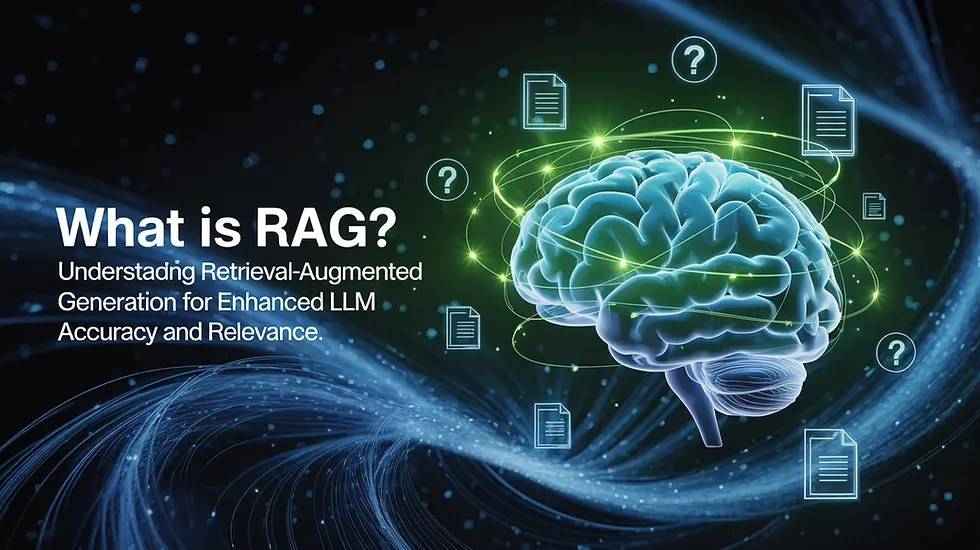Understanding MCP: The Model Context Protocol Powering AI’s Next Leap
- Gareth Moore
- Aug 28
- 3 min read
Artificial Intelligence is moving beyond being a standalone model you prompt and wait for a response. Today, AI systems need to interact with real data, execute tasks with external tools, and integrate seamlessly into existing workflows. That’s where MCP (Model Context Protocol) comes in.
MCP is quickly becoming a foundational layer for modern AI, bridging the gap between language models and the outside world. In this article, we’ll break down what MCP is, why it matters, and how it can be applied in real-world applications.

What is MCP?
At its core, the Model Context Protocol (MCP) is a standard that defines how AI models, applications, and tools communicate.
Think of it as a universal interface between an AI model and external systems. Instead of each developer building a custom way for AI to access APIs, databases, or applications, MCP provides a consistent, predictable contract.
With MCP:
The AI model knows what tools are available.
It understands what inputs are required.
It can reliably interpret the outputs.
This creates a structured, error-resistant way to let AI use external resources.
Why MCP is Important
AI on its own is powerful, but limited. Without context and external integration, it’s like having a brilliant assistant locked in a room with no access to the internet, your files, or your business systems.
MCP solves this problem by:
Enabling Seamless Integration AI can securely tap into business databases, APIs, and tools without custom connectors for each case.
Standardizing Communication Developers no longer need to reinvent the wheel for every new AI integration. MCP ensures consistency across tools and platforms.
Enhancing Reliability and Safety Since the protocol defines inputs and outputs clearly, AI models can avoid “hallucinating” the wrong commands or misusing tools.
Scaling AI Use Cases Once you have MCP-enabled tools, any AI system that supports MCP can use them — dramatically accelerating AI adoption in enterprises.
Example Applications of MCP
Let’s look at how MCP could play out in practice.
1. Customer Support Automation
A support chatbot powered by GPT can use MCP to:
Access your company’s knowledge base (MCP server for documentation).
Query your CRM for customer details (MCP server for Salesforce or HubSpot).
Create support tickets automatically (MCP server for Jira or Zendesk).
Instead of being a “dead-end chatbot,” it becomes a fully integrated support agent that takes real action.
2. Business Intelligence & Analytics
Imagine asking your AI:
“Show me the sales trend for the last quarter, broken down by region.”
Through MCP:
The model connects to a BI system or SQL database.
Executes the proper query.
Returns a chart or structured data directly to the user.
This turns natural language into actionable business insights without a data analyst in the loop.
3. Developer Productivity
In a software company, an MCP-enabled AI could:
Pull tasks from GitHub or Jira.
Run code analysis tools.
Deploy builds to staging environments.
Developers simply tell the AI what they want done, and the AI uses MCP to execute through established tools safely and consistently.
The Future with MCP
The importance of MCP lies in standardization. Just as USB transformed how we connect devices to computers, MCP will transform how we connect AI to the tools we use every day.
For business leaders, MCP means AI can integrate faster into workflows without expensive custom development.
For developers, it provides a clean, predictable way to expose tools and data to AI safely.
For end-users, it means AI won’t just answer questions, it will take action.
MCP is not just a technical innovation, it’s a paradigm shift that will define the next generation of AI-powered applications.
Are MCPs similar to APIs
MCP is very much like an API layer, but specifically designed for AI models.
How it’s like an API
APIs expose functions, data, or actions in a structured way.
MCP does the same — it tells the AI:
What tools exist (endpoints/functions)
What inputs they need (parameters)
What outputs look like (response format)
So instead of the AI “guessing” how to call a system, MCP gives it a clear contract just like APIs do for humans or apps.
How MCP is different from a regular API
Built for AI, not humans: Instead of docs that a developer reads, MCP is machine-readable so the AI instantly understands how to use it.
Model Context Awareness: It standardizes how an AI can discover and interact with external tools during a conversation, keeping context intact.
Multi-tool by design: An MCP server can expose multiple tools or data sources under one protocol, making it easier for an AI to switch between them.
Final Thought: If AI is the brain, MCP is the nervous system that connects it to the world. The companies that adopt MCP early will be the ones that unlock the true potential of AI in their operations.


